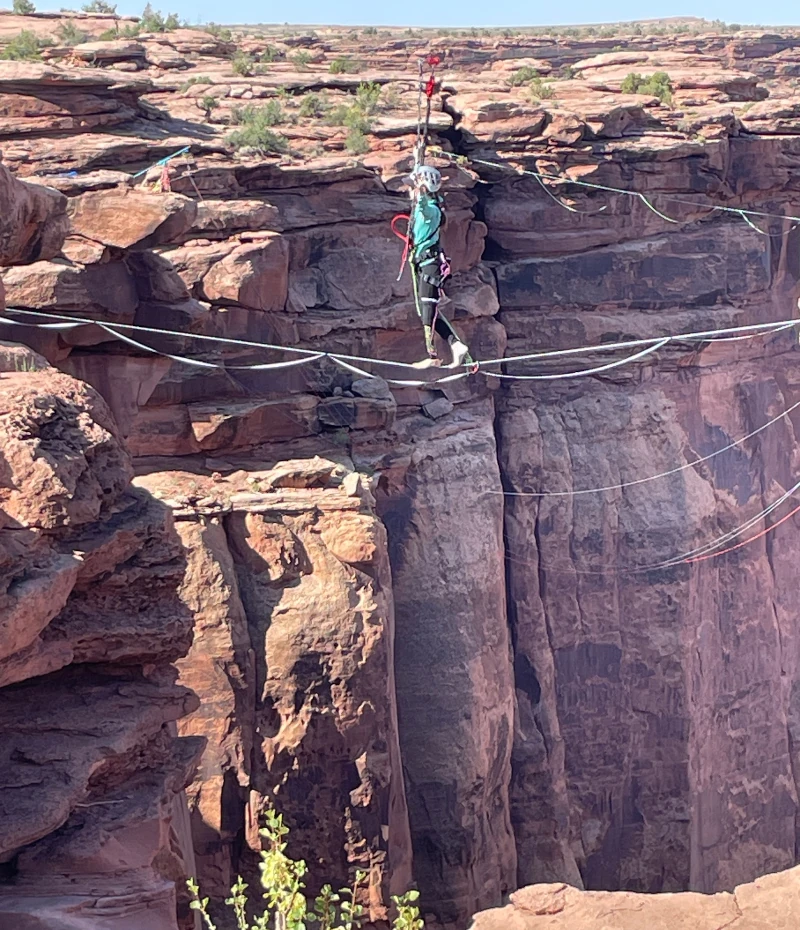
“I’ve always had terrible balance,” says Breeanna Elliott. That’s not an uncommon refrain among lower-limb amputees, even those who (like Elliott) grew up with a limb difference and have walked with the same gait all their lives.
So how did she end up traversing a slackline strung between two sheer, 300-foot-high redrock cliffs near Utah’s Canyonlands National Park? “At first it seemed impossible,” Elliott laughs. “But I’ve learned to trust my body, and I’m willing to fall. I have fallen a lot. And I’ve learned to trust that.”
To be clear, Elliott doesn’t mean she has plunged glumly to the desert floor, a la Wile E. Coyote. She’s spent two years practicing on slacklines just a few feet off the ground, tumbling off and getting back on more times than she can count—not unlike what many new amputees go through while learning to walk with a prosthesis. The process has tested her patience as times. But the effects have been transformative.
“It’s given me a lot of self-confidence,” explains the 32-year-old Elliott. “It’s a meditative exercise that requires thoughtful breathing and full awareness of where your weight is, how your hips move, where your feet are. It’s given me a level of body awareness I’ve never had before, and that’s critical for amputees. That’s one of the reasons I’ve started to prosyletize this. I think there should be a slackline in every prosthetist and PT clinic. The beauty of it is that the bar is really low. Just take a step—that’s all you have to do.”
Elliott’s desire to introduce more amputees to slacklining led her to Faith Dickey, world renowned for her mastery of highlining (ie, slacklining at extreme elevations). Dickey, who operates the nation’s first highlining guide service (Elevate Outdoors), shares Elliott’s convictions that a) anyone can learn to walk a highline (or slackline), and b) it’s a whole-health activity that strengthens mind, body, and spirit.
That’s the roundabout answer to the question of how Elliott found herself balancing in midair on a slackline. Last weekend, she and four other people with disabilities gathered in Moab for a day-long highlining session with Dickey at the Fruit Bowl, one of the sport’s most iconic locations. Three of the participants—including a dude who lost his leg above the knee just eight months ago—had never previously walked a slackline at any height, much less at the Fruit Bowl’s dizzying altitudes. Nevertheless, everybody made the harrowing crossing with relative ease.
Everyone also fell multiple times, but NBD: Dickey’s failsafe system of harnesses, straps, carabiners, and helmets kept everyone intact and unharmed. By day’s end, Elliott was falling off the line on purpose to practice her remounts, while one of the first-timers was belting out show tunes as she skipped across the canyon. “It was the best weekend,” Elliott said afterward.
She hopes it will be the first of many. Elliott and Ryan Juguan (another of last weekend’s Fruit Bowlers) have launched the Adaptive Slacklining Association, a brand-new nonprofit dedicated to building a connected community of slackliners with disabilities. If you’re interested in learning more, send a DM via Instagram @adaptiveslacklining.
We’ll be writing more about Elliott’s slacklining journey in a future print edition. For now, here’s a quickie Q+A transcript (lightly edited) of our conversation with her a few weeks before the Fruit Bowl festivities.
How did you get introduced to slacklining?
Some friends showed me how to do it. It was a little frustrating at first, because they didn’t have any experience with amputees or disabled people, so there were this level of overenthusiasm. I was like: Calm down, I just took one step ok? When I looked online to try to find videos of amputees slacklining, there was almost no information about adaptive slacklining. That was one of the main inspirations to start the Adaptive Slacklining Association. The goal is not only to introduce this to people and talk about our own individual ways of adapting, but also to explain why these skills are so important for daily life, preventing falls, and just staying healthy.
I have the impression that this is a very tactile sport. Every time I’ve seen people do it, they’re barefoot or in their socks. Since your left foot is prosthetic, what adaptations do you have to make for that?
It is extremely tactile, in the sense that you must trust the rope by feeling it with your feet. You should never be looking down at the line at all, because that affects your balance. You need to be looking up the entire time and feel where your foot goes. Obviously I feel nothing on my left side, so I’ve had to develop a lot of trust by concentrating on where I’m putting my knee. I don’t take steps the same way other slackliners do. I don’t have that much movement in my ankle component, so I’ve become really good at pushing my heel against the rope first. Sometimes I’ll use my big toe to touch a particular spot on my foot shell, and that would tell me that my feet are in line. The goal is stay completely in line with the rope, with only side-to-side movement, and only with your arms. But I can’t predict when my foot will be a little off, so I move around more. It’s a less elegant way of slacklining. When I was first learning, people were trying to correct that and telling me not to move, but that’s just not an option for me. I’ve actually gotten pretty good with a lot of movement to compensate for my left leg, but it’s controlled movement.
How long did it take you to figure all of this out?
It took me a while, a lot of trial and error. When I first started, I had people watching me and trying to correct me in particular ways that are pretty common to the sport, but not things I could do. I could get a couple of steps in, but I never felt like comfortable until I started doing it on my own and working with my own body. Before slacklining, I could never balance on my left leg, and I thought it was truly impossible. And now I have pretty fabulous balance, better than someone who has a full limb.
Has your prosthetist supported you in this? Or are they afraid you’re going to injure yourself?
David (Mahler) has been incredibly supportive. When I first started slacklining, I told him I have gained balance that I’ve never had before. David was like, “Send me a video,” and he was blown away. He has been encouraging me to continue with my interest and making suggestions. He suggested that I try a hydraulic ankle. I was pretty reluctant, because it’s not very good for running, but David was itching for me to try it. He gave me a display model so I could check it out, and it did give me a range of movement I’ve never had, and that has been really helpful in the movement I have to do to get my foot on the line. This leg has a dynamic component that allows me to put pressure on the line, and then the foot moves down. That has made it possible for me to do some moves that I couldn’t have adapted as easily.
At what point did you start thinking you might be good enough to try highlining?
One of the first people who introduced me to slacklining made it seem that highlining might be impossible for me, and that never sat very well with me. I knew highlining existed, and I just really wanted to try it. After I started doing really well [with slacklining], I started thinking I could really do [highlining]. But there’s a pretty significant barrier to it, because you need a lot of safety gear. So I just randomly called Faith, and I explained who I am and why I’m interested. She was really enthusiastic. Just a few weeks earlier she had worked with someone who had brittle bone disease, and that was an awesome experience for her and she wanted to open up the sport to more people. That fit right into my vision of this being a community. I didn’t want to be a singular disabled person in a community of slackliners who are not disabled.
Stay tuned for more coverage in Amplitude about the Adaptive Slacklining Association and the Fruit Bowl highline outing.




